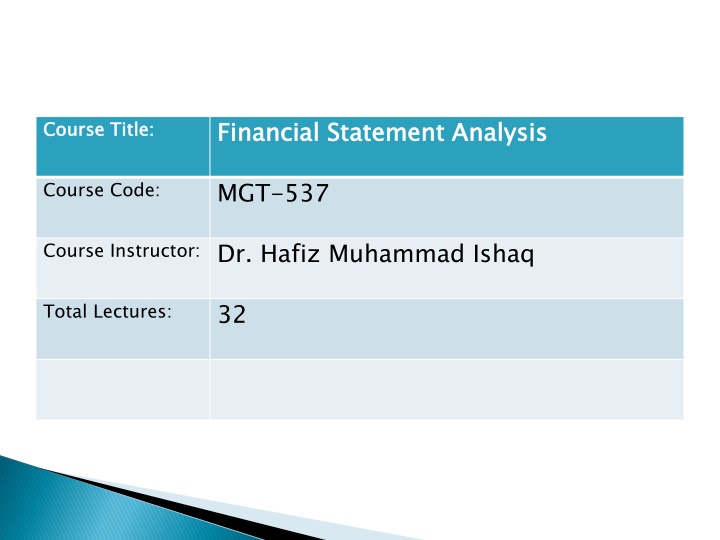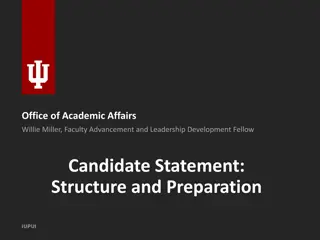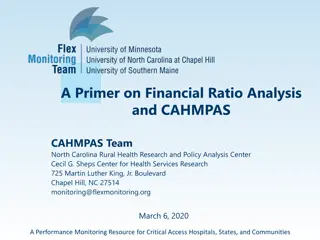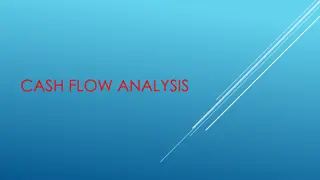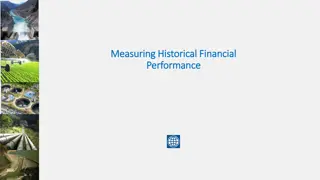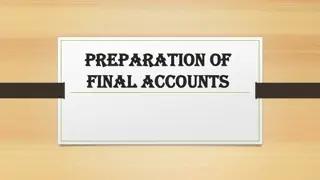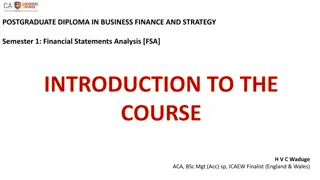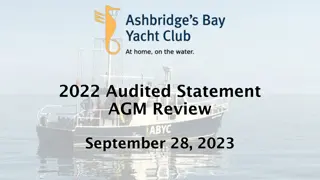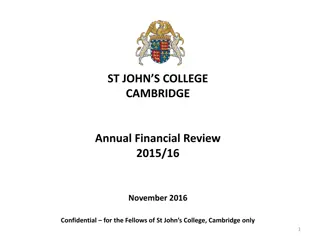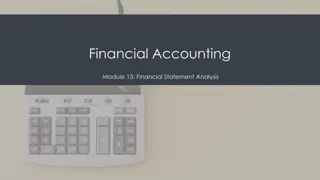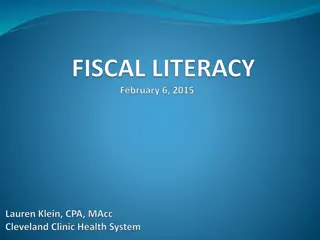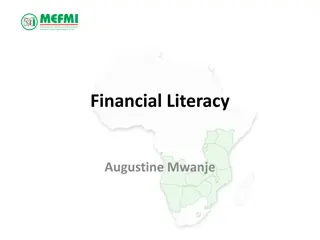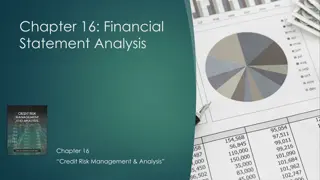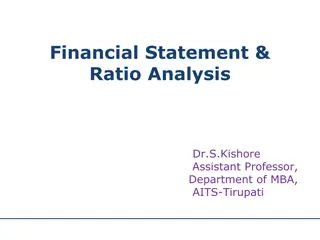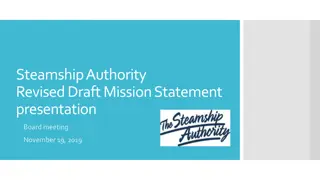Financial Statement Analysis Course
Dive into the world of financial statement analysis with a focus on forms of business entities, the accounting cycle, and key financial statements such as the balance sheet and income statement. Understand the differences between sole proprietorships, partnerships, and corporations, and learn how to interpret income statements and stockholders' equity to analyze the financial health of a business entity. Explore the fundamental concepts through lectures and practical examples in this comprehensive course.
Download Presentation

Please find below an Image/Link to download the presentation.
The content on the website is provided AS IS for your information and personal use only. It may not be sold, licensed, or shared on other websites without obtaining consent from the author.If you encounter any issues during the download, it is possible that the publisher has removed the file from their server.
You are allowed to download the files provided on this website for personal or commercial use, subject to the condition that they are used lawfully. All files are the property of their respective owners.
The content on the website is provided AS IS for your information and personal use only. It may not be sold, licensed, or shared on other websites without obtaining consent from the author.
E N D
Presentation Transcript
Financial Financial Statement Analysis Statement Analysis Course Title: Course Title: MGT-537 Course Code: Course Instructor: Dr. Hafiz Muhammad Ishaq 32 Total Lectures:
Forms of Business Entities The Financial Statements Balance Sheet (Statement of Financial Position) Income Statement (Statement of Earnings) Statement of Owners Equity Statement of Cash flows The Accounting Cycle, Auditor s Report
Sole Proprietorship Partnership Corporation Numerous (shareholders) 2 or more (partners) Number of owners 1 Legally separate from owners Owners liable for business debts No No Yes Yes Yes No To the corporation as earnings; to the owners when dividends are received Subchapter S profits are taxed at ownership level only To the owners Profits taxable To the owner LLC limits liability of owner; may increase income tax exposure Modified form
Income statement Statement of stockholders equity Balance sheet Statement of cash flows Support for the financial statements is provided by notes
Dated for a specific period Summarizes revenues and expenses Reports net income Excess of revenues over expense Net income increases retained earnings Income Statement Revenue $ 120,000 Expenses (100,000) Net Income $ 20,000
Dated for a specific period Reconciles beginning and ending balances of the stockholders equity accounts Capital Stock Retained Earnings Etc. Links the income statement and the balance sheet Income Statement Revenue $ 120,000 Expenses (100,000) Net Income $ 20,000 Statement of Stockholders Equity Capt. Stk. Ret. Earn. Beginning Balance $20,000 $ 5,000 Net income Dividends Ending Balance 20,000 (10,000) $ 15,000 $20,000
Shows the financial condition of an entity as of a particular date Assets: the resources of the business Liabilities: the debts of the business Equity: the owners interest in the business The Accounting Equation: Assets = Liabilities + Stockholders Equity Income Statement Revenue $ 120,000 Expenses (100,000) Net Income $ 20,000 Statement of Stockholders Equity Capt. Stk. Ret. Earn. Beginning Balance $20,000 $ 5,000 Net income Dividends Ending Balance $20,000 $ 15,000 Balance Sheet Assets Liabilities Stockholders Equity Capital Stock Retained Earnings 35,000 20,000 (10,000) Assets = Liabilities + Capital Stock + Retained Earnings $110,000 25,000 50,000 $110,000
Covers the same period as the income statement Three sections Cash flows from operating activities Cash flows from investing activities Cash flows from financing activities
An integral part of the financial statements Required presentation Summary of significant accounting policies Contingent liabilities Subsequent events relating to conditions that existed at the balance sheet date Disclose and adjustment of the financial statements Subsequent events relating to conditions that did not exist at the balance sheet date Disclosure but no adjustment of the financial statements
1. Recording transactions 2. Recording adjusting entries 3. Preparing the financial statement
Internal or external event that causes a change in a company s assets, liabilities, or stockholders equity Recorded in a journal (journal entry) Posted to general ledger accounts Double-entry system Debit: left side of an account Credit: right side of an account Debits = Credits Account Title Debit Credit
Example.No.1 The owner of a lawn service company prepares monthlyfinancial statements. Prepare the appropriate adjusting entries for July 31 based on the following information available at the end of July. a. The annual insurance amounting to $1,200 went into effect on July 1. The Prepaid Insurance account was debited and Cash credited on the same date. b. The lawn service company s lawn tractor was purchased for $3,200 last year. The value of the lawn tractor at the end of its estimated four-year useful life was determined to be $800. This information was made available to record amortization for July. c. A customer paid for the entire summer s service in April. The journal entry credited the Unearned Service Fees account when the payment was received. The monthly fee is $500. d. The last weekly salary of $1,400 was paid to employees on Friday, July 27. Employees are paid based on a five-day workweek. Salaries for July 30 and 31have accrued. e. Service fees of $1,800 were earned by July 31 but not recorded. Refer to (d) above. Prepare the entry to pay the salaries on Friday, August 3.
The Cutlerys August 31, 2011, unadjusted trial balance appeared as follows:
The following additional information is available for the month just ended: a. Amortization of $50 per month will be taken on the furniture. b. It is estimated that the store equipment will have no value at the end of its estimated five-year (or 60-month) useful life. Barbara Schmidt will record a full month of amortization for August. c. It was determined that the balance in unearned revenue at August 31 should be $420. d. The prepaid insurance represents six months of insurance beginning August 1. e. Accrued revenues at August 31 totaled $65. Required 1. Prepare the adjusting entries needed on August 31, 2011, to record the previously unrecorded items. 2. Prepare T-accounts for accounts affected by the adjusting entries. Post the adjusting entries to the T-accounts. 3. Prepare an adjusted trial balance. 4. Prepare an income statement, a statement of owner s equity, and a balance sheet.
The Mike Szabo Company engaged in the following transactions during the month of December December 2 Made credit sales of $4000 (accepted accounts receivable). 6 Made cash sales of $2500. 10 Paid office salaries of $ 500 14 Sold lands that originally cost $2,200 for $3,000 cash 17 Paid $6,000 for equipment 21 Billed clients $900 for services (accepted accounts receivable). 24 Collected $1,200 on an account receivable. 28 Paid an account payable of $700 Required : Record the transactions using T- accounts.
